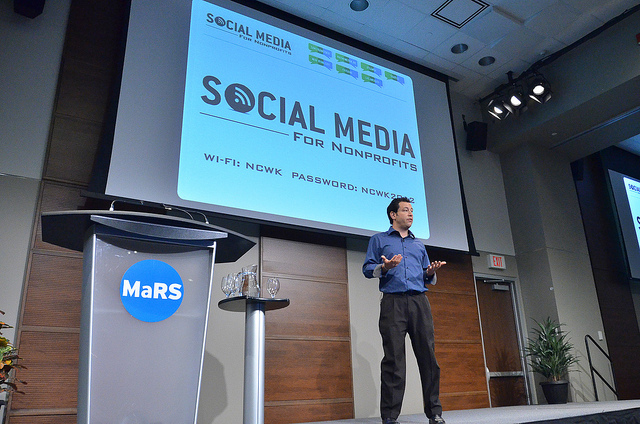
Tried & true techniques — plus a conference discount code
Target audience: Nonprofits, cause organizations, foundations, NGOs, social enterprises.
Guest post by Ritu Sharma
Social Media for Nonprofits
 As Social Media for Nonprofits, the country’s only conference series devoted to social media for social good, plans its Oct. 5 return to the nation’s capital, we thought it would be helpful to share three of the simplest, most practical tips some of our 100+ presenters (including Socialbrite’s JD Lasica and John Haydon) have shared with the 3,500+ nonprofits we’ve educated and empowered to date.
As Social Media for Nonprofits, the country’s only conference series devoted to social media for social good, plans its Oct. 5 return to the nation’s capital, we thought it would be helpful to share three of the simplest, most practical tips some of our 100+ presenters (including Socialbrite’s JD Lasica and John Haydon) have shared with the 3,500+ nonprofits we’ve educated and empowered to date.
Optimal times for email and social media posts
1With email, the guiding rule is that you don’t want to be unread message number 38 of 62 when someone gets back to work from the weekend, so the best time to blast your list is mid-morning or mid-afternoon Tuesday, Wednesday or Thursday. On the other hand, with social media, your Facebook posts and tweets should be timed to catch people in their downtime. 8:45am when they’re on their way into work, 12:30pm when they’re checking their iPhone eating a burrito, 5:30pm on the bus ride home, and according to research, the single best time to post during the week is 9:30-11pm, after the kids go to sleep. Of course you should experiment with your own unique base and see what works, plus bear in mind what time zone(s) they’re in and try out on weekends.
Ask questions to stoke a conversation
2Simply put, if your tweet or Facebook post ends in a question mark vs. a period, you can expect about five times the amount of likes/comments/shares, retweets, etc. Why? Well, social media isn’t about monologue — it’s about dialogue. So instead of just making a statement, ask a question and invite your audience into a conversation!
Become a content curator
3Imagine going to a cocktail party and winding up chatting with someone who only talks about themselves, their work, and their needs. Time for an imaginary call or text to provide cover while you excuse yourself, right? The same is true with social media. As Kay Sprinkel Grace noted, “People don’t give to you, they give through you.” Your audience may care about your organization a bit, but what they really care about is the kids, cause or animals you serve, and the impact you have in the world. So try and balance your posts by ensuring that at least half of them don’t just talk about your needs and updates but rather about the issue you represent. Establish yourself as a thought leader and the followers and dollars will follow.
At Social Media for Nonprofits, we like to say we’re not doing our job if our conferences just leave our attendees inspired. Our job is to inspire them to action. The real question is, after a one-day event, what can you do differently tomorrow that makes you more effective and more efficient at advancing your cause? Hopefully these three simple tips are something you can put to work immediately to drive better results online.
We hope you can join us in DC on Oct. 5 to see top speakers from Facebook, LinkedIn, Change.org, Salsa, CARE, Blackbaud, and Constant Contact, or that you can make it to San Francisco on Oct. 11, Austin on Oct. 23, Seattle on Nov. 5, or later on in New Delhi, NYC, Silicon Valley, Vancouver, LA, and Chicago.
Follow us on Facebook or Twitter to stay tuned. Tickets cost $95 for nonprofits with budgets under $500K, including access to the full-day program, breakfast and lunch. Larger nonprofits, consultants, and for-profits can save $20 off the normal registration fee with the “Socialbrite” discount code. Thanks to the generous support of our sponsors, there are a limited number of scholarships available for small nonprofits not otherwise able to attend.
 This work is licensed under a Creative Commons Attribution-NonCommercial 3.0 Unported.
This work is licensed under a Creative Commons Attribution-NonCommercial 3.0 Unported.









Good article! Regarding the timing of social media posts, and your comment ” Of course you should experiment with your own unique base and see what works, plus bear in mind what time zone(s) they’re in and try out on weekends.”
Thank you so much for stating this. Many folks seem to think there is one magic formula that works for every organization every time. There isn’t, and it is important that you try different techniques, gauge the results, and then tweak your strategies from there.
Great tips, Ritu! In regard to when to send email, I think nonprofits might also consider testing different days of the week for their messages and sending it based on what’s relevant for each message. I’ve seen several studies touting different days of the week as the best day to send email and haven’t seen a consistent “best day.” AWeber found Thursday was the best day. eROI reported Monday was the best, Wednesday is the worst. MailerMailer indicated Sun/Mon was best, Tues/Wed was the worst.
Regarding time of the day, several reports have found the morning is the best time, ranging from 6-11. However, mobile click-throughs were recently found to be highest around lunch time. So testing might also help reveal what time works best for an organization.